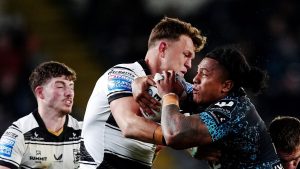Liverpool, site of last surrender in US Civil War, grapples with its Confederate links

Historian Laurence Westgaph leads tours of Liverpool highlighting the city’s slave trading past.
Liverpool, England (CNN) — Tucked away in Liverpool’s Toxteth Park Cemetery, amid the weathered memorials to long-dead residents, lies a link to a little-known part of this famous city’s past.
The two lichen-mottled graves sit side-by-side, as ivy slowly encroaches. These are the final resting places of James Dunwoody Bulloch, and his brother Irvine Stephens Bulloch.
The Bulloch brothers died in Liverpool, but they were born an ocean away, in the US state of Georgia, and — like many Southerners of their generation — fought on the Confederate side in the American Civil War.
James, a foreign agent for the Confederacy, was sent to Liverpool to buy and build ships for its navy. Irvine served in that same navy, on board the CSS Alabama and the CSS Shenandoah — the last Confederate ship to surrender, on the River Mersey, months after the war had ended. When hostilities ceased, neither brother was offered a pardon, so they stayed on in England.
James’s grave features an inscription from the United Daughters of the Confederacy, a US-based Confederate heritage group. Irvine’s tombstone was restored in 2009 by a different neo-Confederate group, the Sons of Confederate Veterans.
At the foot of both sits the iron cross of the Confederate States of America.
As the US grapples with the question of what to do with its controversial memorials to the Confederacy, across the Atlantic in Liverpool, the city is facing the same conundrum.
Strong ties to the Confederacy
Looking at the Bulloch grave markers, historian Laurence Westgaph explained why his city — once the de facto capital of the trans-Atlantic slave trade — has attracted the attention of several groups with Confederate sympathies over the years.
“It was said during the American Civil War that there were more Confederate flags flying here than in Richmond, Virginia — and Richmond was the capital of the Confederacy,” Westgaph told CNN.
Even the classic Civil War-set movie “Gone with the Wind” — a film now under fire for its depictions of racism — makes mention of Liverpool.
The port city of Liverpool was once at the center of the global slave trade.
The city had strong ties to the Confederacy through its shipping industry and the trade in cotton, produced on plantations across the southern states. During the war, blockade-running vessels carried arms across the Atlantic from Liverpool.
“I am sure a lot of people here … liked or enjoyed that connection,” said Westgaph. “That romanticism of the Deep South — the plantations, sitting on the porch drinking mint juleps, peach cobbler in the oven — people don’t associate it with visceral, racial slavery.”
For years, Confederate sympathizers have come to Liverpool to celebrate their heritage.
Now, in the wake of the global Black Lives Matter protests, the city is reconsidering the symbols of that terrible part of its past, and working out how to use them to educate Liverpool’s future generations.
Graves restored, rededicated
The Sons of Confederate Veterans is one of the groups that has made links with the city. The US-based neo-Confederate organization is fighting to preserve America’s Confederate symbols. Calls to remove them have gained new urgency in the aftermath of George Floyd’s death.
In 2009 and 2015, members of the group made two visits to Liverpool.
The Sons of Confederate Veterans attend a rededication ceremony in 2009. Courtesy Sons of Confederate Veterans
Irvine Stephens Bulloch’s tombstone is seen during the 2009 ceremony. Courtesy Sons of Confederate Veterans
“In 2009 the Sons of Confederate Veterans came to Liverpool to a ceremony in order to see the re-dedication of Irvine Stephens Bulloch’s grave and that was paid for by the Liverpool city council,” Westgaph told CNN.
A spokesperson for the Liverpool City Council denied public money was used in the restoration of the Bulloch grave, but photographs from the rededication ceremony in 2009 show members of the Sons of Confederate Veterans dressed in Confederate battle uniforms, standing alongside the then Lord Mayor of Liverpool, Mike Storey, and a city councillor.
The Sons of Confederate Veterans webpage marking the event thanks the city council for paying for the restoration of the tombstone.
“The Lord Mayor of Liverpool, his worship Mike Storey, talked about the work of the council in having the headstone repaired and how the city saw heritage as an important part of its culture,” the text on the site reads.
Storey, who has since been made a Baron and now sits in the UK’s House of Lords, confirmed he was in attendance, but also denied public money was used to restore the Bulloch graves.
“Let me say straight away that had I known what this event was really about I certainly would not have attended,” Storey said in a written statement to CNN.
An iron cross of the Confederate States of America still sits at the foot of Irvine Stephens Bulloch’s tombstone.
Westgaph says there is no denying the Council’s involvement, pointing to multiple blog posts from 2009 and a document from the Mayor of Roswell, Georgia, thanking the city of Liverpool for rededicating Irvine’s grave.
“It makes me think they are insensitive to say the least — either that or just wilfully ignorant,” Westgaph said of Liverpool city officials. “Just because we are in England … that’s not an excuse to be able to commemorate individuals who were involved in keeping other people in chains.”
Sons of Confederate Veterans tour
In June 2015, Dylann Roof, a self-confessed white supremacist, shot and killed nine people in a historically Black church in Charleston, South Carolina. Roof, who was sentenced to death in 2017 for the murders, was repeatedly photographed with Confederate flags.
Four months later, the Sons of Confederate Veterans made another visit to Liverpool. The week-long trip concluded with the unveiling of a plaque honoring Confederate soldiers at 10 Rumford Place, considered by many to be the unofficial embassy of the Confederacy in the city.
“I find this plaque particularly egregious,” said Westgaph, who wants to see it removed. “I think it has no real place in modern Liverpool. This is not the type of thing that we should be commemorating in the 21st century. These were not people who were fighting for a noble cause.”
A plaque commemorates the 150th anniversary of the return of the CSS Shenandoah to Liverpool.
The Sons of Confederate Veterans attend the unveiling of the plaque in 2015. Courtesy Jerry Wells
Jerry Wells’ name is one of those on the plaque. The 76-year-old was a commander of a Sons of Confederate Veterans chapter in Virginia. He says he coordinated the week-long tour, for more than 200 people, with local officials. A Liverpool city council spokesperson denied any involvement.
“It took two to three years of planning. First fundraising and getting people interested in going to Liverpool, which it turned out we had a really great contingent,” Wells told CNN, from his living room in Richmond, Virginia.
During their visit, the group twice raised a Confederate flag in the city, including during a naval battle re-enactment marking the 150th anniversary of the last surrender of the Confederacy — the CSS Shenandoah — which took place in Liverpool on November 6, 1865.
“In fact, we had a 60-foot second national flag flying,” Wells said, a reference to the Confederate flag.
“Once you start gathering down on the Albert Dock, people start noticing you,” he said. “The whole week we were there, people were just in awe of what we were doing. Everybody said they knew nothing about this history with the Confederates.”
People sit near the Albert Dock along the River Mersey in downtown Liverpool.
Wells acknowledged the evils of slavery, but said he wanted to make the people of Liverpool proud of their city’s role in bolstering the South during the American Civil War, “to let Liverpool people know that there was … support in Liverpool at that time for the Confederacy.”
Wells says he is a descendant of a Confederate soldier: “It’s just amazing how my grandfather and other men who survived could go through the carnage at these battles and survive, and I am here today to sing his laurels for being a great trooper.”
Shortly after the 2015 trip to Liverpool, Wells resigned from the Sons of Confederate Veterans. He provided no explanation for his departure and said he did not want to “lambast his ex-organization.”
The Southern Poverty Law Center (SPLC), an Alabama-based non-profit civil rights group that tracks hate crimes, monitors the Sons of Confederate Veterans and its members.
“The underlying cause of the Sons of Confederate Veterans is to lionize and maintain public support of an institution that was designed to maintain white supremacy,” said Howard Graves, Senior Research Analyst at SPLC.
Signage at Rumford Place commemorates the CSS Alabama, a Confederate Navy warship.
Graves said that within the organization there have been individuals who hold dual membership to hate groups.
“I think their desire to maintain friends overseas is particularly bothersome because this is not just harmless pageantry,” he said.
City’s slave trade legacy
It is Tracey Gore’s job to decide how Liverpool should acknowledge its complicated links with the slave trade, as the head of the city’s new Race and Equality Taskforce.
Gore was appointed by the city’s mayor, Joe Anderson, in the wake of the global Black Lives Matter protests following the death of George Floyd.
But she said she had no idea about Liverpool’s past dealings with Confederate heritage groups until CNN contacted her about them.
“I was shocked and naturally it didn’t sit right with me. It absolutely didn’t sit right,” she said, just days before assuming her post.
Tracey Gore leads Liverpool’s new Race and Equality Taskforce.
She said it was now time to change minds inside City Hall. “The city doesn’t know the context,” she said. “They don’t understand the deep-rooted racism that exists within the Confederacy and what that means, and I think it’s born out of ignorance.”
Gore has just six months to create a plan to address systemic racism and inequality across the board in Liverpool — covering everything from policing and education to deciding whether to rechristen streets named after slave traders.
“The legacy of the slave trade in this city is actually the racial inequality and discrimination that still persists, and that’s what our attention should be drawn to,” she said.
Anderson, Liverpool’s current mayor, was not in office when Bulloch’s grave was restored in 2009, but he was in charge during the Sons of Confederate Veterans’ 2015 visit.
A spokesperson for Liverpool City Council said the city’s current government had not had any dealings with the Sons of Confederate Veterans, pointing out that: “No visitors (in any context) need the approval of the council to visit our city.”
“The city and the Mayor have been very vocal in protesting the presence of far-right groups,” the spokesperson added.
Historian Laurence Westgaph carries copies of advertisements showing enslaved people for sale in Liverpool.
No memorial to dead slaves
But Westgaph says it is only too clear who history remembers in Liverpool.
He has led guided tours highlighting the city’s slave history for 25 years, and says there is no plaque, no marker or monument to honor the people brutalized and stolen during the slave trade.
The city’s museum says that “between 1700 and 1807, ships from Liverpool carried about 1.5 million Africans across the Atlantic in conditions of great cruelty.”
Some didn’t make it that far. For years, Westgaph has searched for the graves of the slaves who died in Liverpool so he can memorialize their stories, for the first time.
His research led him to St John’s Gardens, a manicured public square where statues to at least two men linked to the slave trade stand tall.
These towering monuments celebrate the achievements of Arthur Bower Forwood and William Ewart Gladstone. Forwood, a former mayor of Liverpool, made his fortune as a blockade-runner for the Confederacy during the American Civil War.
There have been calls to remove statues of William Gladstone because of his views on slavery.
Gladstone — four times a Prime Minister of Great Britain — has been hailed as “perhaps the greatest British politician of the 19th century.” But his family’s wealth was based on slave labor — his father was one of the largest slave owners in the British Empire.
Gladstone spoke out against abolition, and wanted to recognize the Confederate States of America as an independent nation. In the wake of the Black Lives Matter protests, there have been calls to remove his statues.
“We are actually in a graveyard where many enslaved people were buried,” said Westgaph, gesturing to the ground beneath his feet. “So these memorials of individuals who benefited from the enslavement of African people are actually built on the bodies of enslaved Africans.”
At the beginning of the 20th century, the former cemetery here was landscaped, all traces of its past as a graveyard wiped out.
But Westgaph says he does not want to knock down the monuments to his city’s troubling past, erasing its history.
“I am not a fan of tearing down,” he said. “I would much rather see us retain these monuments and re-interpret them.”
A sign taped to the base of the Gladstone statue explains his family’s links to the slave trade.
Instead, he wants “interpretive plaques put on these monuments to tell people who these individuals were and the role they played in slavery and the slave trade.”
A panel of experts, including Westgaph, is working with the mayor’s office to survey the city and do exactly that — add signs to places, streets, and structures acknowledging their links to the slave trade.
Westgaph is also working with the local government to erect a memorial to enslaved people buried in Liverpool.
He would like to import a stone from West Africa — the ancestral home of many victims of the slave trade — and inscribe it with the few details he has been able to find in the city’s archives and burial records.
“You’ll find entries like: ‘A Black boy belonging to Mr. Penny,’ or: ‘Mr. Fisher’s Black,’ and I think people should be able to see this, so they understand that these individuals at that time were not even deemed worthy of their names.”
An empty flower bed in St John’s Gardens. Historian Laurence Westgaph has launched a crowdfunding campaign to erect a memorial honoring Liverpool’s enslaved people who were buried nearby.
CNN’s Nada Bashir contributed to this report.
Story editor: Bryony Jones
Photo editor: Brett Roegiers







